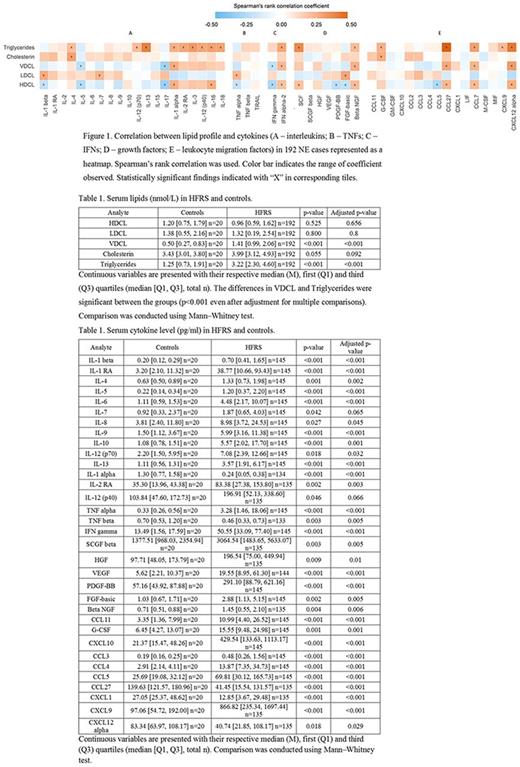Abstract
Hemorrhagic fever with renal syndrome (HFRS) is endemic in the Republic of Tatarstan. Clinically, it is characterized by kidney insufficiency and hemorrhagic disorders. Elevated serum lipase as well as increased cholesterol, total phospholipids and triglycerides has been documented in some HFRS cases suggesting the role of lipid metabolism in the disease pathogenesis. However, little is known about association between serum lipids and cytokine activation in HFRS.
Materials and Methods: Serum samples from HFRS patients admitted to Republican Clinical Hospital for Infectious Disease named after Agafonov were collected along with healthy controls matched for the region. The Institutional Review Board of the Kazan Federal University approved this study and informed consent was obtained from each study subject according to the guidelines approved under this protocol (article 20, Federal Law "Protection of Health Rights of Citizens of Russian Federation" N323- FZ, 11.21.2011). Serum cytokines were probed using Bio Plex Pro Human Cytokine 27-plex Panel and Bio Plex Human Cytokine 21-plex Panels (Bio-Rad, Hercules, CA, USA) multiplex magnetic bead-based antibody detection kits following manufacturer's instructions. Data collected was analyzed using MasterPlex CT control software and MasterPlex QT analysis software (MiraiBio, San Bruno, CA, USA). Standard curves for each analytes were generated using standards provided by manufacturer.
Levels of total cholesterol, tryglycerides and HDCL were determined using Novochol-200 kit, Triglyceride-Novo kit (Vektor-Best, Russia) and HDCL-Cholesterol-Novo-A kit according the manufacturer's instructions. Puumala virus RNA was detected using nested PCR.
Statistical analysis was conducted using R language for statistical computing (www.R-project.org), RStudio (www.rstudio.com) and packages "tableone" (https://CRAN.R-project.org/package=tableone) and "reshape2" (Wickham, 2007). Illustrations were generated using "ggplot2" package (Wickham, 2009). Comparisons were carried out using Mann-Whitney test for continuous variables. Spearman's rank correlation coefficients were plotted as a heatmap. Differences were considered significant at p<0.05.
Results: One hundred and ninety two HFRS patients (156 males and 36 females; median age of 37 years) were recruited into this study. Median duration of hospitalization was 8 days. Twenty controls were also recruited (8 males and 12 females; median age of 26.5). Analysis of HFRS serum lipids showed increased levels of VDCL and triglycerides (p<0.001, Table 1). We also detected significant upregulation of pro-inflammatory cytokines, growth factors and chemoattractants as compared to controls, while levels of TNFβ, IL-1α, CCL27, CXCL1 and CXCL12α were lower (Table 2).
Weak to moderate significant positive correlations between cytokines and lipids were revealed in HFRS cases. Correlations were found between serum triglycerides and IL-4, IL-12(p70), IL-13, IL-1α, IL-2RA, IL-3, IL12(p40), IL-16 and IL-18 (Fig. 1A); IFNα-2 (Fig. 1C); growth factors SCF and β-NGF (Fig. 1D); leukocyte migration factors G-SSCF, CCL27, CCL7, CXCL9 and CXCL12α (Fig. 1E). Cholesterol correlated only with IL-4 and G-SCF, while HDCL was correlated with 8 analytes: IL-1α, IL-16, IFNα-2, SCF, β-NGF, CCL27, CCL7 and CXCL12α. We also observed correlation between VDCL and 6 cytokines: IL-1 α, IFNα-2, β-NGF, CCL27, CCL7 along with CXCL12α. LDCL was correlated with IL-1 β, IL-7, TNFα and bFGF (Fig. 1).
Lack of significant correlation was found between: serum levels of LDCL and factors involved in leukocyte migration as well as interferons (Fig.1C, E); VDCL and TNFs (Fig.1B); cholesterol and IFNs and growth factors (Fig. 1B-D); triglycerides and TNFs (Fig.1B).
Weak to moderate significant negative correlations between cytokines and lipids were also revealed in HFRS cases. Interestingly, significant negative correlation was found between HDCL and 8 cytokines (IL-1β, IL-5, IL-17, TNFα, IFNγ, PDGF-BB, bFGF, CCL5). Out of these 8 cytokines, three (IL-5, IL-17, IFNγ) were also negatively correlated with serum levels of VDCL.
Conclusion: Our data demonstrates correlation between serum lipid and cytokines in HFRS. Strong significant correlations were found between serum triglycerides and cytokines, suggesting that these lipids affect HFRS pathogenesis.
This study was supported by RSF grant 15-14-00016.
No relevant conflicts of interest to declare.
Author notes
Asterisk with author names denotes non-ASH members.


This feature is available to Subscribers Only
Sign In or Create an Account Close Modal